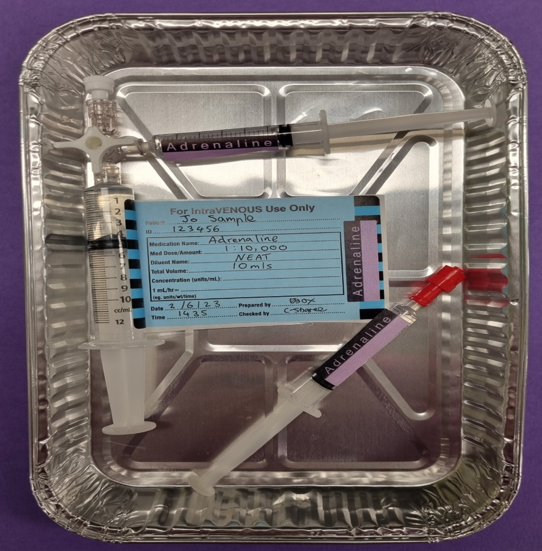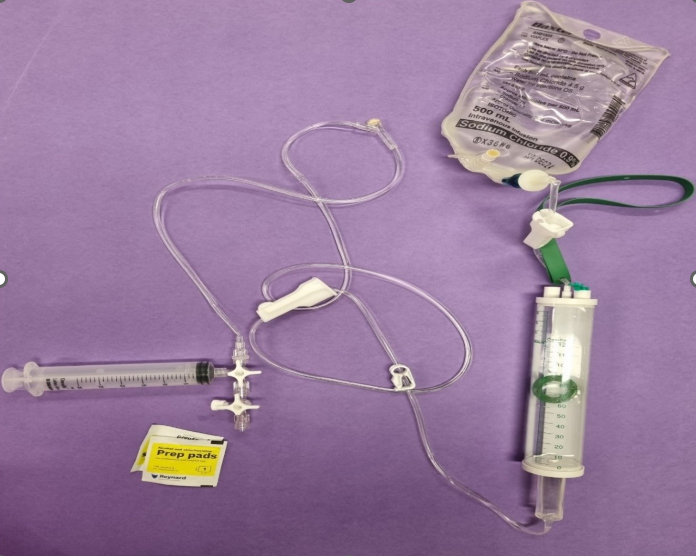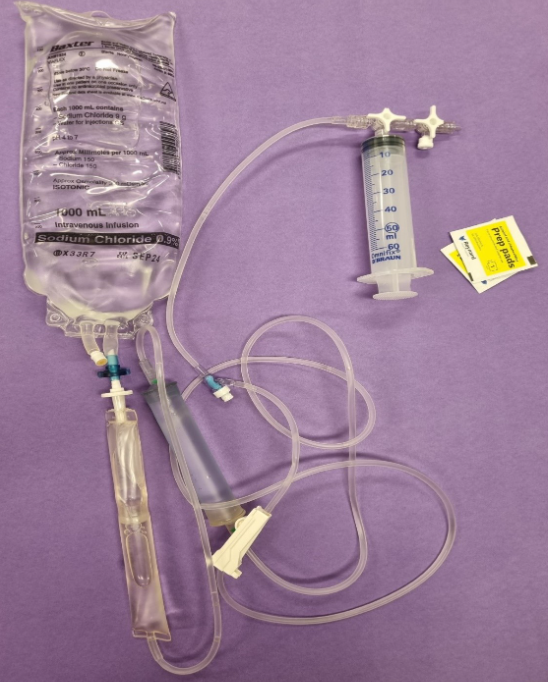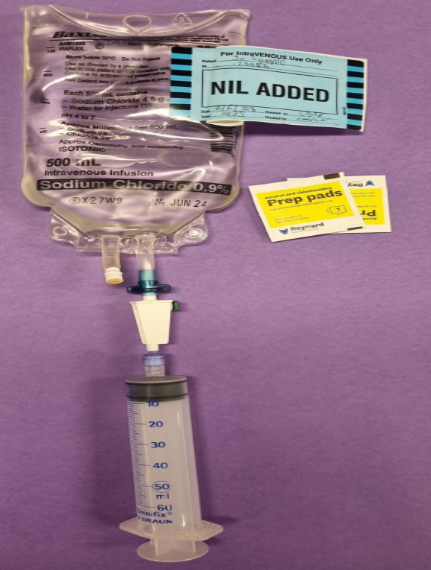Introduction
The ANZCOR (Australian and New Zealand Committee on Resuscitation) guidelines recommends the administration of Adrenaline (epinephrine) and 0.9% Sodium Chloride bolus as treatment in the event of a cardiac arrest for Basic Life Support (BLS) or Advanced Life Support (ALS).
NB-this guideline does not include BLS associated within neonatal inpatients cared for within the Butterfly (NICU) unit within the Royal Children’s Hospital.
Aim
The purpose of this clinical guideline is to describe how to draw up and administer intravenous (IV) or intraosseous (IO) adrenaline (epinephrine) and fluid in a resuscitation situation.
Definition of terms
- Cardiac arrest – A treated cardiac arrest can be defined as an event for a pulselessness patient or has a pulse with inadequate perfusion and receives chest compressions and/or defibrillation of ventricular fibrillation or pulseless ventricular tachycardia (Raymond et al, 2016)
- IV - Intravenous.
- IO - Intraosseous refers to the placement of a specialized hollow bore needle through the cortex of a bone into the medullary space for infusion of medications, fluids and blood analysis.(Feldman et al, 2022).
Management
Please refer to Basic Life Support Guidelines for first line management of paediatric cardiac arrest:
https://www.rch.org.au/clinicalguide/guideline_index/Resuscitation__Hospital_Management_of_Cardiopulmonary_Arrest/
Adrenaline (epinephrine)
- 1:10 000 intravenous or intraosseous for use in emergency resuscitation
- There are two strengths of adrenaline available. Check strength carefully, preferred strength is 1:10 000 Adrenaline (epinephrine) = 1 mg in 10mL. The other available strength is 1:1000 Adrenaline (epinephrine) = 1 mg in 1mL.
- Dose (using the 1:10 000 strength ampoule (preferred)): 0.1mL/kg of 1:10 000 Adrenaline (epinephrine) = 10micrograms/kg, (Maximum single dose of 1 milligram = 10mLs) OR
- Dose (using the 1:1000 strength ampoule): first dilute to 1:10 000 by drawing up the entire contents of the ampoule (1mL) and diluting with 9mL 0.9% Sodium Chloride for injection so 0.1mL/kg dosage (10mcg/kg) is always administered.
Recommend to drawing up the whole 1mL in 1:1000 adrenaline concentration ampoule and dilute with 9mL 0.9% Sodium Chloride for injection so 0.1mL/kg dosage (10mcg/kg) is always administered.
- Adrenaline (epinephrine) doses can be given every four minutes.
- Adrenaline dosage must be:
- Ordered by Medical staff as per RCH ‘Medication Management Procedure’ http://www.rch.org.au/policy/policies/Medication_Management/
- Checked by two Endorsed Clinicians as per RCH ‘Medication Management Procedure’
- Drawn up and administered following RCH hygiene procedures. http://www.rch.org.au/policy/policies/Hand_Hygiene/
Equipment
- 1 x ampoule 1:10 000 Adrenaline (epinephrine) undiluted
(May need further ampoules depending on patient size and if repeated doses are required)
- 1 x 10mL luer lock syringe
- 1 x blunt drawing up needle
- 1 x 3-way-tap
- 2 x purple adrenaline drug labels
- 1 x blue drug label
- 2 x 1mL or 3mL, 5mL or 10ml syringe depending on size of patient and dosage required
- Red caps to protect key parts
- Alcohol wipes
- Medication tray (clean tray or disposable tray) as clean surface.
Procedure
- Draw up the entire 10mL ampoule of 1:10,000 Adrenaline (epinephrine) into a 10mL luer lock syringe with a blunt needle. Double check with another endorsed clinician and label clearly as per RCH drug labelling guidelines.
- Attach a 3-way-tap to the10mL syringe. (see Figure 1)
- Attach the appropriate size syringe for the required adrenaline dose to the 3-way-tap to draw up adrenaline (1mL, 3mL or 5mL).
- Label syringes clearly with drug name, date and time and place in drug tray on resuscitation trolley ready for use as required.
NB: if the above process is leading to any delay in immediate access to first adrenaline dose then an initial dose can be drawn from the ampoule and then the remainder doses drawn up as described above/pictured in figure one.
Figure 1. Example of how to draw up adrenaline remainder of the ampoule drawn up as described above.

- Order by doctor should include drug name, concentration, and microgram dose with what that equals in mL.
- Example for the 28kg patient dose of adrenaline (epinephrine) 1:10,000 is 280 micrograms which equals 2.8mLs.
- If the patient is greater than 50kg then the 3 way tap system is not needed and doses can be drawn up in a 10mL syringe from the ampoule and administered. Further doses can be drawn up from subsequent adrenaline ampoules.
- Check patency of IV cannula/ IO with flush of 0.9% sodium chloride.
- Following the protocol, administer prescribed dose of adrenaline via IV/IO route followed by flush 3-5mL 0.9% sodium chloride.
- Once adrenaline (epinephrine) has been administered document administered drug doses as given on resuscitation narrator or on by the Scribe documented as ordered by doctor and signed by 2 endorsed clinicians.
0.9% Sodium Chloride fluid bolus
Dosage
When hypovolaemia is suspected as the cause of cardiorespiratory arrest, intravenous or intraosseous crystalloid may be used initially for resuscitation as a bolus of 10-20mL/kg.
Additional boluses of crystalloid or colloid solution should be titrated against the response.
(ANZCOR Guideline 12.2 November 2021). http://resus.org.au/guidelines/
- The recommended standard fluid resuscitation dose is 10-20mL/kg of 0.9% Sodium Chloride followed by an additional dose if required.
Adrenaline and fluid bolus must be ordered by a doctor (can be a verbal order initially and documented as soon as practicable)
Patients under 20kg (See Figure 2)
Recommended Equipment required:
- 500mL bag 0.9% Sodium Chloride (0.9% saline)
- IV administration set with dosage burette (Dosifix®™ 150mL burette macro dropper)
- 2 x 3-way-taps
- 30mL syringe
- Alcohol wipes
Procedure
- Connect both 3-way-taps to patient end of Dosifix® green burette line.
- Attach 30mL syringe to 3-way-tap furthest away from the patient for fluid administration.
- Ensure rolling clamps are on
- Endorsed clinician is to double check the 500mL 0.9% Sodium Chloride bag with second endorsed clinician.
- Spike 0.9% sodium chloride bag, open clamps on burette line and prime line (including 3-way-taps)
- Attach to cleaned by wipe IV/IO patient access site using non-touch technique protecting all key parts. Infuse medication administer as ordered. Bolus can be administered via gravity (not IO), or by using the 30mL syringe attached to the 3-way-tap, the fluid is drawn from the burette then manually infused into the patient’s access site (once each syringe is administered to the patient the volume is announced to the Leader or Scribe).
- Administer as per order.
Figure 2. Dosifix Burette 3 way tap configuration for Fluid Administration

Patients over 20kg (See Figure 3)
- Recommended equipment required:
- 1000mL bag 0.9% Sodium Chloride (0.9% saline)
- Tutahand pump set (rapid flow manual pump).
- 2 x 3-way-taps
- 30mL or 50mL syringe
- Alcohol wipes
Procedure
- Connect both 3-way-taps to patient end of Tuta line (rapid flow manual pump).
- Attach 30mLsyringe to 3-way-tap furthest away from the patient for fluid administration.
- Ensure Tuta line (rapid flow manual pump) clamps are on.
- Endorsed clinician double check the mL 1000mL 0.9% Sodium Chloride bag with second endorsed clinician.
- Spike bag 0.9% Sodium Chloride bag, invert fluid chamber on line, open clamp and prime line including 3-way-taps.
- Attach to cleaned by wipe IV/IO patient access site using non-touch technique protecting all key parts. Fluid can be rapidly infused by squeezing fluid chamber on Tuta line with hand. Volume of fluid delivered is assessed by observing the volume lines on the 1000mL Sodium Chloride
- 0.9% bag. Bolus can be also administered by using the 30mL or 50mL syringe attached to the 3-way-tap, fluid is drawn from the burette into the syringe then manually infused into patient’s access site (once each syringe is administered to the patient the volume is announced to the leader or scribe).
- Administer as per order.
Figure 3. Tuta hand pump set and 3-way-tap configuration and fluid administration

NB: if the above process is leading to any delay in immediate access to a fluid bolus then an initial bolus of 50mL 0.9% Sodium Chloride can be drawn from the individual plastic saline ampoules with blunt needle or a Swan-lock® with a 50mL syringe attached to a 500mL bag while a fluid line is being primed.
Figure 4: Swan-lock set up

Acute management
- Administration responsibilities for endorsed clinicians:
- Ensure patency of IV cannula before administering fluid bolus. Ensure the cannula site can be visualised during fluid bolus.
- Ensure fluid bolus has been ordered
- During administration of fluid monitor IV site.
- Continue to monitor fluid bolus administration until completed.
- Once completed confirm the volume has been delivered to the medical staff member or Team Leader and Scribe.
- Document fluid bolus as per RCH documentation policy.
- Document patient observations
Special Considerations
- Patient safety alerts
- Potential adverse events
-
Should all 1:10000 ampoules be used in a resuscitation, consider using the 1:1000 strength ampoule (undiluted)): 0.01mL/kg of 1:1000 Adrenaline (epinephrine) = 10micrograms/kg
Companion Documents
Links
Evidence Table
The evidence table for this guideline can be
viewed here.
Please remember to
read the disclaimer.
The review of this nursing guideline was coordinated by Laura Box, Nurse Educator, Resuscitation Programs, and approved by the Nursing Clinical Effectiveness Committee. Reviewed July 2023.